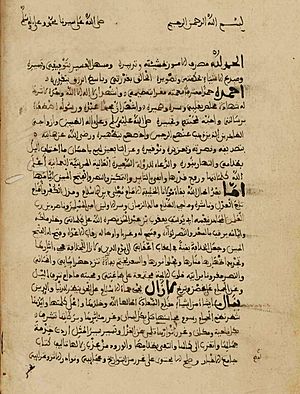Rawd al-Qirtas facts for kids
Rawḍ al-Qirṭās (which means "The Gardens of Pages" in Arabic) is a very old and important history book. Its full name is Kitāb al-ānīs al-muṭrib bi-rawḍ al-qirṭās fī ākhbār mulūk al-maghrab wa tārīkh madīnah Fās. This long title means "The Entertaining Companion Book in the Gardens of Pages from the Chronicle of the Kings of the Maghreb and the History of the City of Fes". The book tells the stories of the rulers of the Maghreb region (which includes countries like Morocco, Algeria, and Tunisia) and also shares the history of the city of Fes.
The short title, Rawḍ al-Qirṭās, has a cool double meaning. It refers to "The Gardens of Pages," like pages in a book. But it also points to a real public garden in Fes called "The Garden of al-Qirṭās." This garden was named after Ziri ibn Atiyya, who was nicknamed al-Qirṭās.
Who Wrote Rawḍ al-Qirṭās?
Before printing presses were invented, books were copied by hand. Because Rawḍ al-Qirṭās was so popular, many copies were made. This led to some confusion about who the real author was. Some copies say the author was Ibn Abi Zar from Fes, while others name Salih ibn Abd al-Halim from Granada.
Most experts today agree that Ibn Abi Zar was the original author. Famous historian Ibn Khaldun also said this. It's thought that Abd al-Halim might have just summarized the book. Experts believe the author was from Fes because the book has a lot of detailed history about that city. Also, it sometimes makes small mistakes about the geography of Iberia (modern-day Spain and Portugal), which suggests the writer wasn't from there.
What Does the Book Cover?
Rawḍ al-Qirṭās covers a long period of history, starting from when Idris I arrived in 788 AD. It continues up to the Marinid Dynasty in 1326 AD. The book is divided into four main parts, each focusing on a different group of rulers:
- The Idrisid and Maghrawa kings
- The Almoravids
- The Almohads
- The Marinids
Historians find the first and last sections of the book very helpful for understanding those time periods. However, the parts about the Almoravids and Almohads have some mistakes. They contain errors in dates, facts, and sometimes leave out important information. Because of this, these sections are not always reliable. It's interesting that Ibn Khaldun, a very respected historian, used this book as one of his main sources, even with its known issues.
How We Read It Today
Over time, different versions of Rawḍ al-Qirṭās have been published.
- In 1843, a scholar named Tornberg created a very important version of the Arabic text. He used all the different handwritten copies he could find. This version is still used today as the basis for modern Arabic editions. Tornberg also translated the book into Latin.
- A French translation was published in 1860 by Beaumier, but it wasn't based on as many old copies and is now considered to have some errors.
- A Spanish translation by Huici Miranda, especially its second edition from 1964, is highly respected. It has many helpful notes and is considered a very accurate version.
See also
 In Spanish: Rawd al-Qirtas para niños
In Spanish: Rawd al-Qirtas para niños


